Recent Crackdown Targets Baha’i Community: Nine Arrested In Tehran
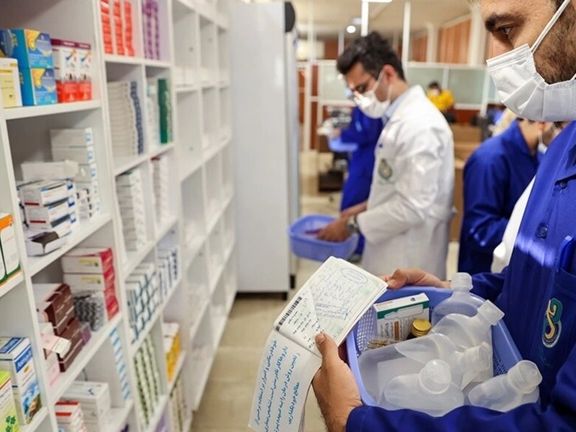
In a recent surge of repression against the Baha'i community Iranian security have arrested nine citizens in Tehran and closed 40 drugstores and warehouses owned by Baha’is.

In a recent surge of repression against the Baha'i community Iranian security have arrested nine citizens in Tehran and closed 40 drugstores and warehouses owned by Baha’is.
The Ministry of Intelligence of the Islamic Republic divulged details in a formal statement on Sunday, revealing the nature of the arrests. "The detained Baha'i family and their accomplices were engaged in the realm of medicines and cosmetics, " according to the Ministry.
Baha'i activists shared additional insights with Radio Farda, the Persian Service of Radio Free Europe in Prague, identifying those affected by the crackdown. These sources indicated that the Ministry of Intelligence agents conducted visits to the Tabibian family's pharmacies and warehouses, during which, they also confiscated communication devices belonging to some employees.
The ministry cited various accusations against the detained individuals, including "drug smuggling and hoarding, money laundering, and tax evasion." As a result, the security agency reported the seizure of "20 pharmacies and 3 cosmetics companies and warehouses" linked to the Tabibian family. Usually in such cases seized assets end up in the hands of regime organizations and insiders.
Over the years, the Islamic Republic's security entities have subjected adherents of the Baha'i faith to undue pressure, often under the pretext of security concerns. These actions have frequently culminated in the confiscation or seizure of their properties.
The ongoing plight of Baha'is in Iran continues to raise international concerns. Presently, three members of Yaran-e Iran, a Baha’i community group remain incarcerated under security-related orders.
The Islamic Republic of Iran refuses to acknowledge the Baha'i faith, and the followers of this religion have been subjected to extensive restrictions and hardships since 1979.
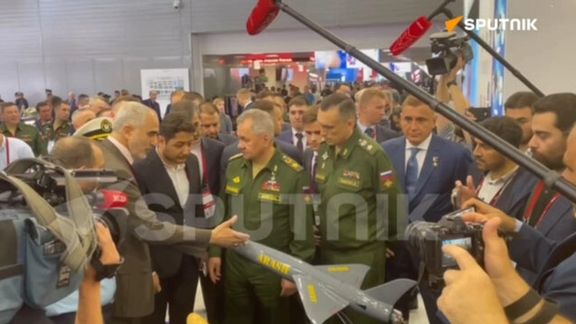
Russian Defense Minister Army General Sergey Shoigu visited the military stands of several countries, including Iran’s at the Army-2023 International Military-Technical Forum
The ongoing Army-2023 International Military-Technical Forum held at the Patriot Congress and Exhibition Center outside Moscow, the Alabino shooting range, and the Kubinka airfield, gathers military enterprises to discuss development within the Russian Armed Forces.
At the Iranian stand, Shoigu showed particular interest in a range of unmanned aerial vehicles (UAVs) and electronic warfare systems. Among the showcased items were the Arash, Ababil-5, and Karrar UAVs, alongside the Hunter-2 electronic warfare system.
Iran’s delegation, led by Deputy Chief of Staff of Iran's Armed Forces, Aziz Nasirzadeh, has been a consistent presence at such events.
Iran has previously denied allegations of sending armed drones to Russia during the conflict that ensued after Moscow's invasion of Ukraine. The Iranian government stated that any such shipments, if they did occur, took place before the war.
Nevertheless, Russia's utilization of Iranian-made drones for attacks on Ukrainian infrastructure and civilian targets has drawn international criticism. Western powers have raised concerns over Iran's involvement in arming Russia with these drones, along with the possibility of supplying additional weaponry and ammunition.

Questions abound following the deadly shooting Sunday at a religious shrine in southern Iran, with the government announcing arrests as people widely speculate.
Iran’s judiciary said on Monday that eight suspects have been detained over the attack on Shahcheragh, a funerary monument and mosque in Shiraz that was the site of a similar attack less than a year ago.
Saying that all detained suspects were foreign nationals, the judiciary's Mizan news agency said the main perpetrator was identified as Rahmatullah Nowruzov, a citizen of Tajikistan, while the nationalities of the other suspects remained unknown. Tasnim, a media outlet affiliated with the Revolutionary Guard said 10 foreigners were arrested in relation to the attack.
According to NourNews, a media outlet close to Iran's Supreme Council of National Security, one person was killed and ten people were wounded when the shooter opened fire at the premises of the shrine before being arrested.
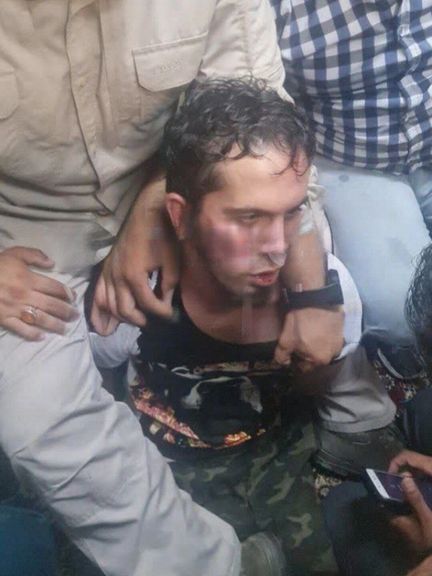
The regime’s state broadcaster announced that the Islamic State group (ISIS) has claimed responsibility for the attack, but so far there is no evidence of any statement by the terror group.
In last year's attack when 15 people were killed at Shahcheragh, the Islamic State claimed responsibility. The militant group, which has claimed other attacks in Iran -- including the deadly twin bombings in 2017 that targeted Iran's parliament and the tomb of the Islamic Republic's founder Ruhollah Khomeini – has played the role of boogeyman in regime’s narratives of regional developments to justify its military presence and support of other foreign militias, and strict security atmosphere inside the country.
A large number of regime officials, including parliament speaker Mohammad-Bagher Ghalibaf, Foreign Minister Hossein Amir-Abdollahian and President Ebrahim Raisi as well as several lawmakers and military commanders, vowed revenge against those behind the attack.
In a vague remark, Foreign Ministry spokesman Nasser Kanaani said, “The attack on worshippers is a heinous act of vengeance in response to the significant blows that Iran dealt on terrorists in the battlefields.” The governor of Fars province, Mohammad Hadi Imaniyeh, attributed the motive of the assailant to "vengeance" for the execution of two individuals involved in last year's attack.
In July, Iran publicly hanged two Afghan men who were accused of "providing weapons, procurements, logistics, and guidance of the main perpetrator", which bears uncanny resemblance to the Sunday shooting. The lone gunman, armed with an assault rifle, entered the shrine last October and opened fire, and was subsequently shot and later died in hospital. He was also identified as a Tajikistan citizen. The October attack coincided with anti-regime protests in Iran. This prompted speculation and accusations that the government orchestrated the incident as a diversion from the protests and as a pretext for further crackdown.
Within the Iranian social media sphere, opinions diverge on how to respond to the attack, with some holding the regime accountable for either incompetence or possible involvement, while others echo the regime's stance in condemning the extremists.
A large number of people criticize the regime for focusing its forces and surveillance methods for cracking down on women who refuse to wear the hijab, rather than real criminals. Additionally, some speculate that this attack was orchestrated to divert public attention away from the ongoing political debate regarding the enforcement of new hijab laws, currently undergoing final deliberations in parliament.
In the lead-up to the anniversary of last year's nationwide anti-regime protests in September, Iranian authorities have heightened security measures, resorting to intimidation and threats in an attempt to prevent public demonstrations. Some believe that the attack on Shahcheragh was orchestrated to provide a pretext for tighter security measures.
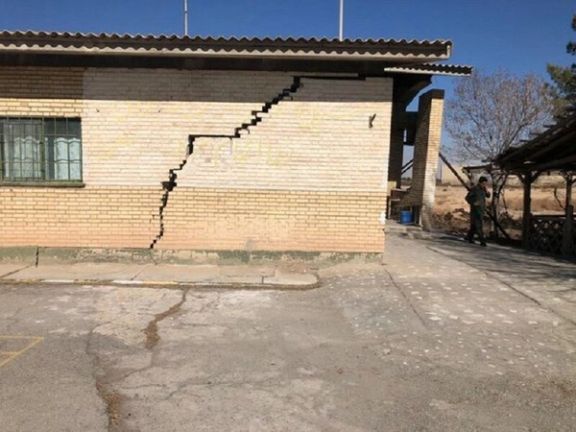
Iran’s Deputy Minister of Education has said that several schools in the central province of Esfahan (Isfahan) have been evacuated due to land subsidence.
Hamidreza Khan-Mohammadi also raised concerns about the situation in schools located in Yazd and Tehran.
Speaking to the ILNA news agency on Sunday, Khan-Mohammadi highlighted the severity of the subsidence issue in Esfahan province, stating that "we have evacuated some schools" due to the problem. He assured that these evacuated schools would be renovated to strengthen them against the threat of land slippage.
The provinces of Tehran, Khorasan Razavi, and Esfahan are at highest risk of land subsidence, with Esfahan metropolis under particular threat. Khan-Mohammadi confirmed this emphasizing that Esfahan faced the greatest challenge of subsidence with limited cases being reported in Tehran. Yazd also experienced subsidence, which resulted in damage to schools, although the extent of damage was reported to be less significant.
Recent assessments indicate that around 4.24 million residential units in land subsidence zones lack proper structural support.
The issue of land subsidence extends beyond major urban centers to large construction projects. Across numerous regions in Iran, ground cracks and significant depressions resembling meteor craters have emerged on the surface in recent years.
According to experts, over-extraction of groundwater has played a pivotal role in the creation of underground cavities, resulting in the occurrence of land subsidence.
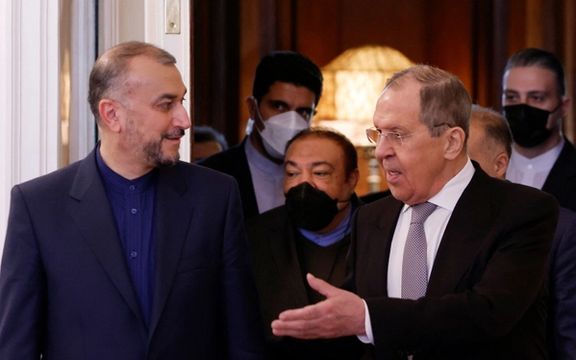
The intensification of international sanctions against Russia has made Iran a potentially major trade partner for Moscow, a website in Tehran said on Saturday.
According to Rouydad24, Iranian officials have started to think of Russia as a $100 billion market for Iranian goods. This, however, is an outlandish expectation given Iran’s own isolation due to sanctions, its crippled economy, and the need for technology and raw materials hard for Iran to acquire.
The volume of trade between Moscow and Tehran reached $4 billion between January and October 2022, a far cry from the $100 billion figure. Russian officials have said that the volume of trade will reach $7.5 billion by 2025.
However, the main area of cooperation between Moscow and Tehran is political and military. The two have been allies in the Syrian civil war and their military ties have been expanding since Russia’s invasion of Ukraine. Iran supplied hundreds of kamikaze drones to Russia that have been extensively used against Ukrainian civilian and infrastructure targets.
Western countries have imposed new sanctions on Iranian individuals and entities for aiding Russia in the war, but a recent move by the United States to release billions of dollars in frozen Iranian funds in exchange for 5 American hostages means Tehran will remain undeterred to expand military ties with Moscow.
Rouydad24 quoted Iranian exporter Ali Hosseinian as saying that the figure will be initially increased to $8 billion, but the final target for trade between Iran and Russia is $40 billion per year.
In the meantime, Russia's export to Iran has grown by 27 percent while Iran's export to Russia also grew by 10 percent in 2022. Iran and the Eurasia Economic Union consisting of Russia, Kazakhstan, Belorussia, Armenia and Kirgizstan signed an agreement in early 2023 to boost exchange of goods, services and labor. Meanwhile, Iran and Russia agreed to cooperate in the areas of technology and logistics, while also signing several other agreements for cooperation in the areas of aircraft manufacturing, oil and gas pipelines and natural gas field development.
Iran is Rusia's second biggest trade partner among the Caspian Sea littoral countries, Rouiydad24 wrote, adding that some 90 percent of Russia's export to Iran are food and agricultural products. At the same time, some 60 percent of Iran's exports to Russia also consist of agricultural products. The rest of its exports to Russia include minerals, construction material, and plastics.
Meanwhile, Iran has called for a boost in Russia's exports to Iran particularly for wheat, grains, maze and cooking oil ingredients. According to the Rouydad24 Russia is capable of providing these items. Iran imports around $10 billion of wheat, maze, various edible oils and animal feed annually and potentially Russia can provide all these as a single-source exporter.
According to Reuters, one controversial item among Iran's imports from Russia is gasoline which Russia sells to Iran at a price $12 per ton higher than market prices.
Earlier this year Russia's VTB Bank opened a branch in Tehran and Iranian experts said that the branch will facilitate Iran's safe and low-cost access to the banking systems of Europe, Africa and Asia. It is not clear how this can be done while the Western and other international sanctions are in place against both Tehran and Moscow. International access for Russia’s own banking system has been severely restricted.
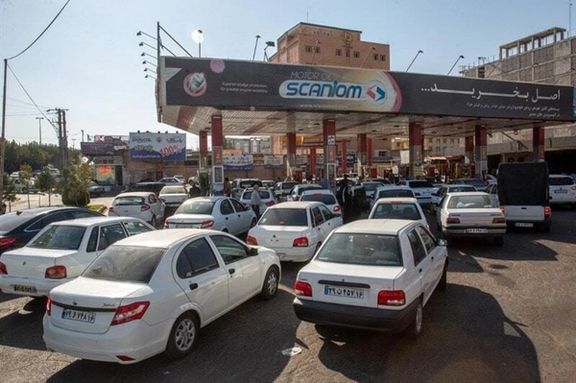
In response to a large gap between gasoline production and consumption, Iran has scaled back its distribution and turned to using its strategic reserves.
According to Iran International sources, the Iranian Oil Ministry has taken the step citing the need to curb smuggling. The other option would be to raise prices but the regime is worried that it could trigger protests across the nation.
The National Iranian Oil Refining and Distribution Company (NIORDC), a department within the ministry, has released around 900 million liters of strategic gasoline reserves into the market in an effort to make up the deficit. An informed source disclosed that the country's reserves now stand at approximately 500 million liters, barely enough for more than four days in the event of any production-related disruptions.
The source added that there are challenges for gasoline imports both domestically and internationally, leading to a consistent reduction of gasoline distribution in various regions of the country.
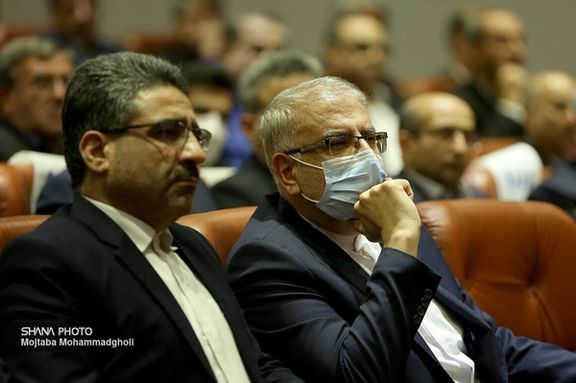
Both Oil Minister Javad Owji and NIORDC Manager Ali-Akbar Nejadali have confirmed the supply restriction. Nejadali explained that in light of increased summer travel and to ensure a steady distribution and prevent station closures, a new measure has been introduced, limiting each refueling session to only 30 to 40 liters.
Iran International reported in late July that the government has postponed tighter fuel rationing implementation due to the approaching anniversary of last year's anti-regime protests in September.
Earlier in the month, NIORDC deputy manager Ali Ziyar said that the average daily consumption of gasoline has hit 124 million liters, indicating a 20-percent increase compared with the previous year. “In recent years, the maximum annual growth in gasoline consumption has been seven percent, but this year we have suddenly experienced a 20 percent increase in consumption,” he said, tacitly acknowledging that a large amount of fuel is being smuggled out of the country. He also stated that the daily gap between production and consumption is 17 million liters.
The government, which controls one of the world's largest oil and gas reserves, sells gasoline at extremely low, subsidized prices, charging less than 10 US cents per gallon, or less than 3 cents per liter, while neighboring oil-producers have much higher prices, in line with international market rates. Second only to Venezuela, Iran has the world’s cheapest gasoline price. The extremely low fuel prices leads to small and large-scale smuggling to neighboring countries.
Back in March, Iran International unveiled a classified document detailing a late February meeting at the presidential office. This document revealed that dangerously low levels of strategic fuel reserves forced major refinery repairs to be postponed to maximize short-term production. Officials were advised to avoid any public statements or suggestions that could be construed as intentions to raise current fuel prices, fearing it might ignite public discontent.
One of the main reasons that the Islamic Republic has not managed to increase prices in the midst of the current economic crisis is because it faced the worst wave of unrest in years since September 2022. A fuel price hike would risk fanning the flames of unrest further. For years there has been talk of adjusting prices, but since 2018 Iran’s currency has dropped 12-fold and any increase needs to be huge to be meaningful in US dollars.
In November 2019, a government decision to increase fuel prices by 50–200 percent triggered a cycle of protests and unrest across the country that lasted for over two weeks. Regime forces killed at least 1,500 civilians, in the worst such crackdown in Iran.
While the country is hugely dependent on the revenues from crude oil exports, due to sanctions and mismanagement, it has failed to modernize the energy sector, with power shortages persisting most of the year. Systemic corruption also further cripples the weak system. The situation has been grave in recent years but since the administration of Ebrahim Raisi assumed office in 2021, the entire energy management system is going haywire, drawing backlash from not only the public but even regime insiders.
In recent days, rumors of an impending gasoline price increase have once again ignited, prompting a rush of people to gas stations.